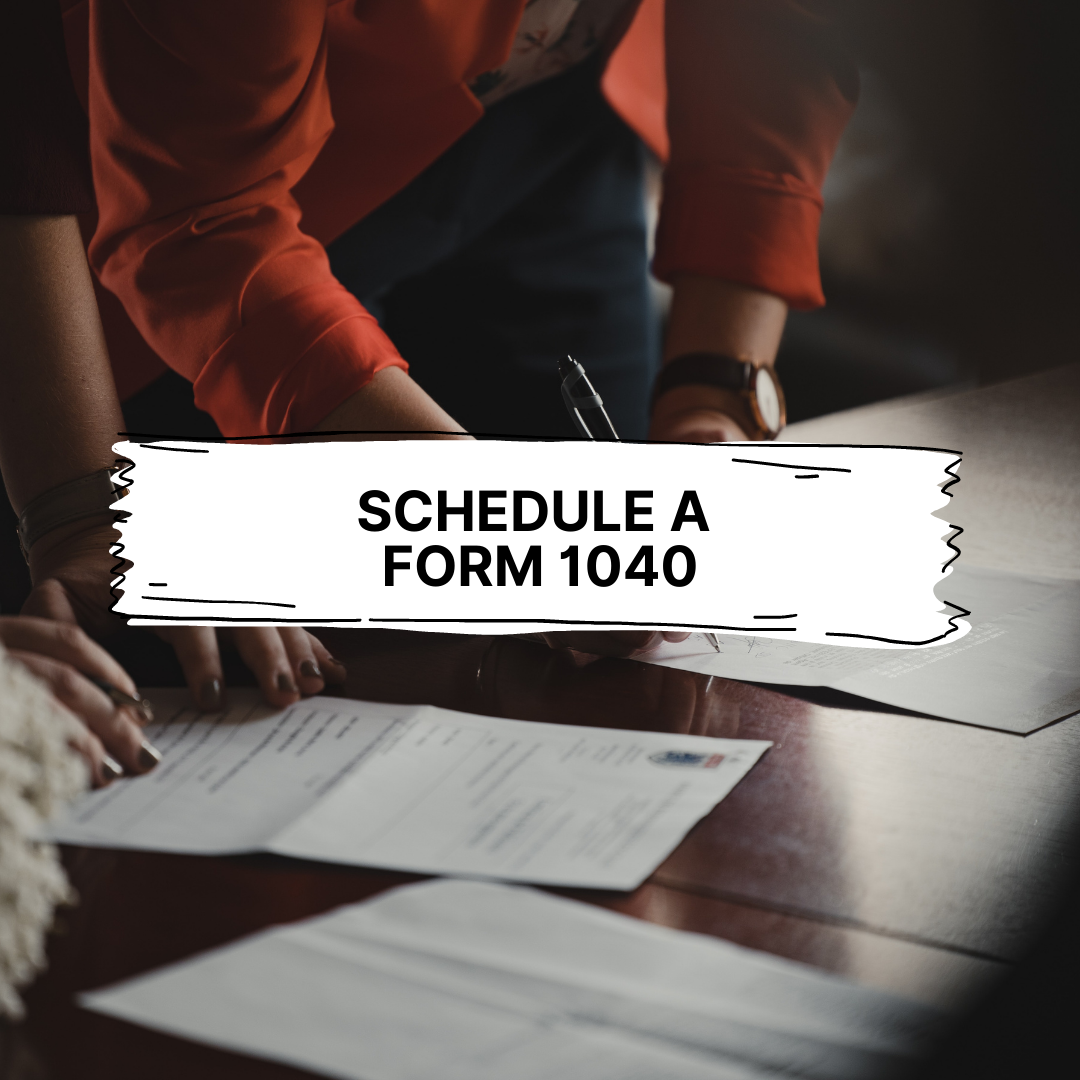You will be able to save additional taxpayer money if you claim Schedule A (Form 1040) itemized deductions, over standard deductions.
Keeping that in mind, here's what we will be dealing with:
- What Is a Schedule A (Form 1040) IRS form?
- Purpose of Schedule A (Form 1040) IRS form
- Create a Schedule A (Form 1040)
- Comparison to the standard deduction
- Schedule A (Form 1040) tips
- Itemize Deductions 2021 for Schedule A (Form 1040)
- Unpaid medical and dental expenses in Schedule A (Form 1040)
- Long-term Care Insurance Premiums in Schedule A (Form 1040)
- Taxes You Paid Schedule A (Form 1040)
- Interest You Paid in Schedule A (Form 1040)
- Donations to charity in Schedule A (Form 1040)
- Personnel expenses and other miscellaneous expenses in Schedule A (Form 1040)
- Total itemized deduction limit for each item in Schedule A (Form 1040)
- Who Can File Schedule A (Form 1040): Itemized Deductions?
What Is a Schedule A (Form 1040) IRS form?
The Internal Revenue Service provides all taxpayers with the opportunity to itemize deductions or request standard deductions. The standard deduction amount depends on the registration status. However, if you have significant deductible costs for the year and the total exceeds the standard allowance, you can list the costs by reporting the costs in Schedule A (Form 1040) itemized deductions.
For individual taxpayers, they can use Schedule A (Form 1040) to report itemized deductions. If you choose individual deductions instead of standard deductions, use Schedule A (Form 1040) to list the deductions. The total amount reported will be deducted from your taxable income.
Purpose of Schedule A (Form 1040) IRS form
Schedule A (Form 1040) is required each year to itemize your deductions. The schedule includes 7 categories of expenses that have various requirements and restrictions on the amount that can be deducted.
Create a Schedule A (Form 1040)
You don't have to fill out every line or include expenses in every category when you create Schedule A (Form 1040). You only need to claim what you are entitled to. For many taxpayers, just one deductible expense is enough to justify the itemizing on Schedule A (Form 1040).
For example, a mortgage interest deduction alone is very important and can itself be larger than a standard deduction. After completing the schedule and applying certain restrictions, transfer the total deduction amount on Schedule A (Form 1040).
Comparison to the standard deduction
You can claim various personal expenses by itemizing deduction items using Schedule A (Form 1040). However, there could be times when this may not be economically meaningful as it exceeds the standard deduction. For example, in 2021, the standard deduction for a taxpayer is $ 12,000. If you have $ 2,000 in a charitable donation and you pay $ 3,000 in mortgage interest that year, your itemized deductions will be $ 5,000. In this case, you can save more income tax by claiming a standard deduction instead of claiming for itemized deductions
Schedule A (Form 1040) tips
- You must maintain detailed and accurate financial records of expenses throughout the year to create Schedule A (Form 1040). This will also help assess the deductibility of each expense. There are times when itemized deductions, like the sales tax or property tax, are ignored. For example, you can deduct property taxes on any vehicle that your own – even a boat or mobile home as well as your own home. As of 2018, federal and local tax deductions are limited to $ 10,000 per year
- You can deduct either the state income tax or the state sales tax you pay, but you cannot deduct both. To calculate your sales tax deduction, you need to keep a receipt for your purchases made during the year to maximize tax savings. Alternatively, you can request the amount from the IRS sales tax table instead
- You can deduct costs in standard or itemized deductions. If you're not sure whether to use the itemized or the standard deductions, you simply need to create a tax return on eFile.com and submit it electronically and you can rest assured that the results will be in the best interests based on the latest tax updates
Itemize Deductions 2021 for Schedule A (Form 1040)
To classify the deductions, the total deductions in Schedule A (Form 1040) must take into account the amount that exceeds the federal standard deductions. In general, most taxpayers do not fall into this category due to the significant increase in standard deductions in 2018. For 2021 filings, use the eFile Tax app to determine which deduction method is best for you. Here is a list of all the Itemized Deductions that you can file under Schedule A (Form 1040):
1. Unpaid medical and dental expenses in Schedule A (Form 1040)
It may be advantageous for you to claim for unpaid (not covered by health insurance) medical and dental care costs for your spouse and dependents in Schedule A (Form 1040). Calculate your standard deductions and the one that works best for you. To find the deduction or breakdown amount, add up the total medical and dental costs of yourself, your spouse, and your dependents in the 2021 tax year. Any amount that exceeds 7.5% of the 2021 adjusted gross income (AGI) can be deducted.
Example:
Suppose the AGI is $ 50,000 and the medical cost is $ 10,000.
The amount that you can claim is $ 50,000 AGI * 7.5% = $ 3,750. Therefore, $ 6250 exceeds the $ 3750 limit of $ 10,000 in medical expenses.
Line 1: Your total medical/dental costs in 2021 (not refunded or paid by others) are: $ 10,000
Line 2: The 2021 AGI of Schedule A (Form 1040) is: $ 50,000
Line 3: 7.5% of AGI is: $ 3,750
Line 4: By subtracting row 3 from row 1, you can deduct the following amount: $10000-$3750= $ 6250 from your expenses.
2. Long-term Care Insurance Premiums in Schedule A (Form 1040)
Long-term care insurance premiums are different from medical expenses. These premiums can be deducted in Schedule A (Form 1040) if the premium exceeds 10% of the adjusted total income (AGI. There is an age limit that must be applied to eligible long-term care insurance.
3. Taxes You Paid in Schedule A (Form 1040)
State and local sales tax (SALT), income tax, and property tax count for itemized deductions that can be listed in Schedule A (Form 1040). The total amount of all three taxes must not exceed $ 10,000. Please note that there is no upper limit on state, local, sales, and foreign property taxes deducted in Appendix C, Appendix E, or F. For example, if a person owns and rents real estate, the property tax is unlimited.
Example: If you pay $ 3,000 as property tax on your place of residence and you exceed the standard allowance, it is beneficial to deduct this amount in Schedule A (Form 1040).
4. Interest You Paid in Schedule A (Form 1040)
If you take a loan for buying, building, or renovating your home, you need to pay a Home mortgage interest. You are eligible to deduct only the interest you paid on your mortgage loan in Schedule A (Form 1040), not on the loan amount. The interest amount is provided by the mortgage company for the financial year on Form 1098.
Situation 1 - If you have taken home mortgage debt taken on or after December 15, 2017: Your home mortgage interest deduction is limited to the following debt amounts:
$750,000 for Single, Married Filing Joint/Qualifying Widow/Widower, Head of Household) and $375,000 (Married Filing Separately)
Situation 2 - If you have taken home mortgage debt taken before December 15, 2017, then the mortgage interest deductions are limited to the following debt amounts:
$1,000,000 (single, married co-registered / qualified widow) / Widower, head of household) $ 500,000 (Married Filing Separately)
Currently, the mortgage interest rate cap for the 2026 tax year reverts to the mortgage interest rate paid for all mortgages under $ 1,000,000.
If you sell your home, you can still get up to $ 250,000 in capital gains tax ($ 500,000 if you're married) if you own and use your home as the main home for the last five years.
Example:
Home Mortgage Amount: $ 235,500 Annual interest rate: 4.1% Mortgage annual interest payments: $ 9,655.50 You can deduct interest on a $ 9,655.50 mortgage paid during the tax year.
Major changes in home equity Debts incurred before December 15, 2017, will be deducted from up to $ 100,000 in housing debt paid to improve existing homes or purchase homes. You can also use this debit to pay tuition, credit card debt, or other out-of-home expenses. You can deduct $ 1.1 million in mortgage/debt interest.
You cannot deduct interest on the debt on your 2018-2025 tax return for home assets incurred after December 15, 2017, unless the debt is used to buy, build, or improve a protected home. Interest deductions are limited to $ 750,000 (joint marriage declaration) and $ 375,000 (individual marriage declaration) debt. Debts incurred before December 15, 2017, will be carried over to the old amount above. Unless changed by the new law, the tax year of 2026 can return to its previous state and begin deducting interest on $ 1 million mortgages and $ 100,000 mortgages regardless of when the mortgage was released.
5. Donations to charity in Schedule A (Form 1040)
Charitable allowances have been extended by the Consolidated Expenditure Act of 2021 or the "Second Incentive" Act of December 2020 of up to $300 made during 2020 or 2021, and you don't have to list to get this deduction in Schedule A (Form 1040).
Gifts must be sent directly to charity in cash, not funds recommended by donors or private foundations. Otherwise, you usually need to itemize to get a donation deduction. This has been done by fewer people since the standard deduction doubled a few years ago.
By 2021, married co-applicants will be able to claim a surplus of up to $ 600 for such donations.
Overstatements of your income tax return charity can result in a penalty of 50% of the tax underpayment due to overvaluation.
Also, in the case of a tax return for the 2021 tax year, donations to public charities may not exceed 60% of AGI or adjusted total income as they are deducted from the income tax return.
You must keep a record of the following to file in Schedule A (Form 1040):
- A public charity or private foundation is a non-profit IRS registered organization 501 (c) (3)
- Keep a record of your donations (usually a charity tax receipt)
- For in-kind donations, you may require a qualified appraisal to prove the invoiced deduction
- Accidental and theft losses
As the President stated, the individual deductions for personal accident and theft losses, except for losses due to federal disasters, were removed in the tax year 2018-2025. If you need to report these losses, only losses over 10% of your adjusted total income (AGI) will be deducted.
6. Personel expenses and other miscellaneous expenses in Schedule A (Form 1040)
For the 2018-2025 tax year, employment costs and other deductions limited to adjusted total income or 2% of AGI will be excluded. This includes non-refundable costs incurred at work. The 2018-2025 tax return does not take into account employee and tax preparation costs.
7. The total itemized deduction limit for each item in Schedule A (Form 1040)
There is no limit to the number of itemized deductions in Schedule A (Form 1040) for the tax year from 2018 to 2025.
So, once again, let us look at the popular itemized deductions that can be filed for in Schedule A (Form 1040):
- Mortgage interest deduction
- Deduction for local income taxes and state income taxes paid
- Medical expense deduction
- Charitable donations deduction
- Casualty and theft losses in a state-declared disaster area
- Gambling losses
- Casualty and theft losses of income-producing property
- Losses from Schedule K-1
- Federal estate taxes on income
- Amortizable bond premiums
- Ordinary loss because of bond investments
- Repayments of Social Security/other income
- Certain unrecovered investments in a pension
- Impairment-related work expenses for the disabled
- Mortgage interest deduction
- State and local income tax deductions paid
- Medical expenses will be deducted
- Donation deduction to charity
- Damage caused by accidents and thefts in disaster areas declared by the state
- Gambling loss
- Accidental loss and theft of assets that generate a certain income
- Loss from schedule
- K1 Federal estate tax on income
- Amortizable bond rewards
- The normal loss that can be allocated to a particular bond investment
- Certain social security or other income repayments
- Certain non-refundable investments in pensions
- Work expenses related to impairment for people with disabilities
Who Can File Schedule A (Form 1040): Itemized Deductions?
- Any US taxpayer can submit a Schedule A (Form 1040). Eligibility for itemized deductions in Schedule A (Form 1040) is an alternative to standard deductions, and taxpayers have the option of allowing greater savings
- Many of the deductions once available to taxpayers have been extinguished by the tax cuts and employment laws passed in 2017
- The new law also limits the amount taxpayers can deduct from state and local taxes to a maximum of $ 10,000 and $ 5,000 for separate taxpayers. At the same time, the law almost doubled the standard withholding amount. The numbers are adjusted annually
- In the financial tax year 2021, the standard deduction for single taxpayers and married persons filing separately is $ 12,550. For couples submitting together, it's $ 25,100. For the head of household, it's $ 18,800
- In the 2022 tax year, the standard deduction for single taxpayers and individual couples is $ 12,950. The couple applying together is $ 25,900 and the head of household is $ 19,400
- Thus, many taxpayers who listed their itemized deductions in Schedule A (Form 1040) over the last few years feel that it is more convenient to claim a standard deduction
Conclusion
Schedule A (Form 1040) is an optional appendix and its purpose is for taxpayers to guide taxpayers through acceptable tax credits to reduce their overall tax obligations. How much you can save depends on your tax class and deduction amount. However, many taxpayers do not have the right to reduce or eliminate any of the individual itemized deductions described above. Now you should be clear about how Schedule A (Form 1040) itemized deductions have been changed, restricted, or abolished.
Key Takeaways
- Schedule A (Form 1040) is used by the taxpayers to file the itemized deductions. These taxpayers choose to itemize deductible costs rather than making standard deductions
- With tax cuts and the 2017 tax cuts by the Employment Act (TCJA), many deductions have been abolished and the size of standard deductions has almost doubled
- Many taxpayers who list the deduction amount before TCJA in Schedule A (Form 1040) find it more convenient to claim a standard deduction amount
Related Articles












